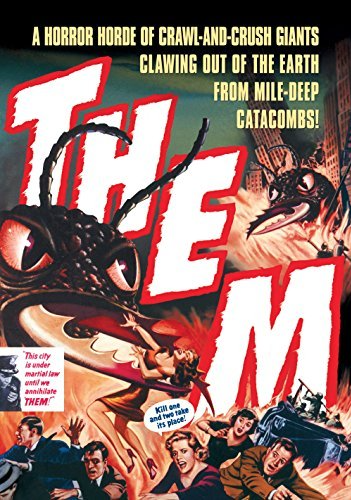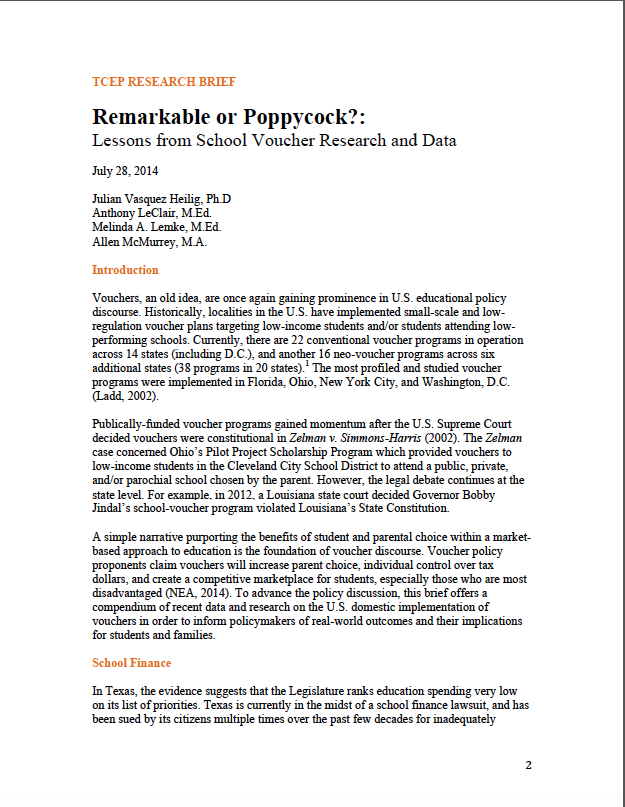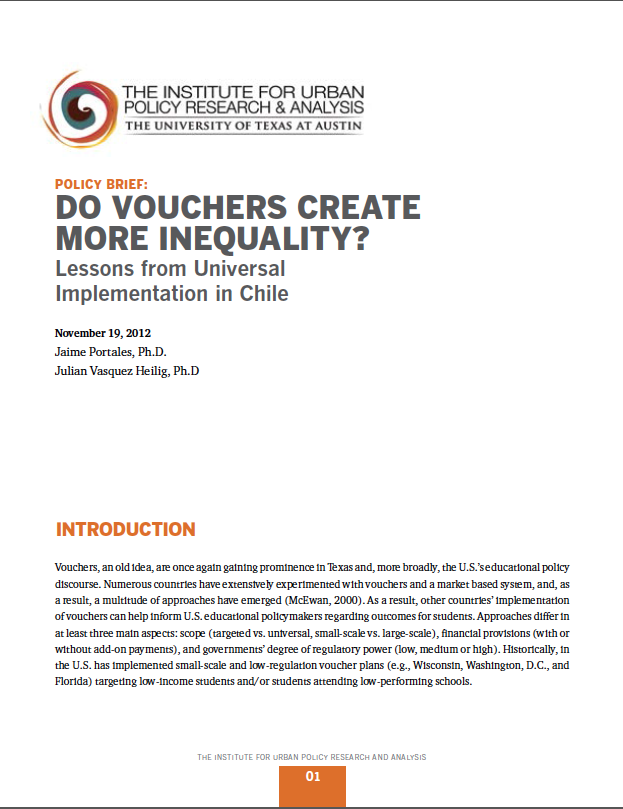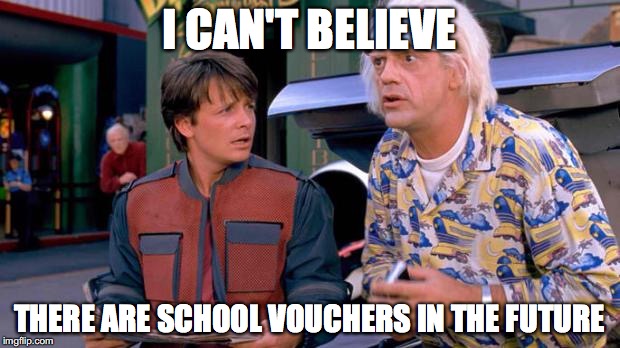We’re in a watershed moment for public education.
Donald Trump has committed to spending $20 billion on market-based school choice, including charter schools and vouchers. He’s also proposed cutting afterschool programs, as well as college grants and federal work study programs for college students.
But the most significant move away from public education our country is making right now is in the expansion of school vouchers—a direct transfer of public money to private schools. Conventional voucher programs simply give parents taxpayer dollars to apply toward private-school tuition. Education Savings Accounts, or “neovouchers,” allow states to circumnavigate constitutional language that bans public funding for private and religious organizations.
In a recent article, Kevin Welner, a professor at the University of Colorado specializing in education policy and law, reported that conventional voucher policies now exist in 16 states, producing about 175,000 vouchers annually. Education Savings Accounts are in 17 states and generate about 250,000 vouchers every year.
Here’s what’s important to know about vouchers:
1. Who popularized school vouchers?
Voucher proponents usually ignore the insidious history of the idea. Milton Friedman, the University of Chicago economist and apostle of free-market fundamentalism, believed corporations should be able to profit from education. In 1997, he wrote “Public Schools: Make Them Private,” arguing that vouchers were “a means to make a transition from a government to a market system,” to enable “a private, for-profit industry to develop” and to abolish the public system of schools.
In 1955, Friedman also wrote that he didn’t believe in government sponsored integration of schools. Friedman saw vouchers as a way to stack schools by race if communities so chose. This is, in fact, what happened. The South used vouchers to create “segregation academies” for whites only.
This history is overlooked by current proponents of school vouchers, who usually frame vouchers as a “limited” approach that would help poor children in cities—even claiming they are a civil right.
2. What do civil rights organizations think about school vouchers?
The political argument that market-based school choice is the answer for longstanding inequalities in the American education system for the poor and youth of color is at odds with the positions of most national civil rights organizations. The National Association for the Advancement of Colored People, Urban League, League of United Latin American Citizens, Journey for Justice, Movement for Black Lives, and many other civil rights organizations all agree that public school privatization and vouchers are far from a civil rights remedy, and instead “siphon away all-too-limited public education funds and fail to provide protection from discrimination and segregation.”
3. Why do some leaders of color support school vouchers?
The school choice movement has worked hard to foster African American and Latino leaders who support vouchers and other forms of privately managed school choice. One example is the Black Alliance for Educational Options in Milwaukee, which is heavily funded by politically conservative foundations. Another, the Libre Initiative, was founded in 2011 and claims to be a “non-partisan, non-profit grassroots organization that advances the principles and values of economic freedom to empower the U.S. Hispanic community.” But Media Matters has reported that Libre’s senior staff are almost all Republican Party campaign veterans, and the organization is backed by more than $10 million in Koch brothers funding—suggesting that Libre is neither non-partisan nor grassroots. Libre representatives place op-eds in newspapers in states with substantial Latino populations, making simplistic, convincing-sounding claims about the benefits of school “choice” for communities of color.
4. Do school vouchers help students?
You can find the rare peer reviewed study—typically funded with resources from pro-voucher organizations and philanthropists—showing a very small positive statistical effect of vouchers for students. However, Martin Carnoy, a Stanford University Professor of Economics and Education argued recently, in a report released by Economic Policy Institute, that the predominance of peer-reviewed research for 25 years shows that vouchers don’t improve student success. “Choice” proponents harp on the limitations of traditional public schools, but they never seem to get around to mentioning the predominance of the peer-reviewed literature demonstrating that vouchers don’t lead to better outcomes.
5. What can we learn from the use of school vouchers from around the world?
In Chile, which has a large voucher program, research has shown that the voucher policy experiment has generated creaming effects, benefiting some groups, but damaging others—especially low-income students in urban areas. Overall, the market-based approach appears to benefit wealthier students and students with the best academic abilities living in mixed or upper income areas.
The data is clear: more than two decades of school vouchers for every child in Chile has resulted in an education system where low-income students have fewer opportunities and even greater barriers to choosing a high-quality school.
6. Why does dark money support school vouchers?
Why are well-heeled conservative philanthropies and organizations such as the Koch brothers, American Legislative Executive Council, Walton Foundation, Heritage Foundation, and Foundation of Educational Excellence spending millions of dollars funding studies and lobbying heavily for vouchers?
Vouchers align with a neoliberal focus on “open markets, privatization, deregulation, and decreasing the size of the public sector while increasing the role of the private sector in modern society.” Vouchers purposefully move the responsibility and funding of public education into the hands of for-profit and nonprofit organizations—and away from the traditional democratically controlled public school system.
7. Are school vouchers constitutional?
Publicly funded voucher programs gained some momentum after the U.S. Supreme Court ruled vouchers were allowable under the U.S. Constitution in Zelman v. Simmons-Harris. However, the majority of voucher funds are provided by state tax dollars. As a result, the legal debate continues in the states. For example, the Nevada State Supreme Court ruled in 2016 that the funding mechanism for Education Savings Accounts were unconstitutional.
8. Do vouchers guarantee school choice for all families?
In 2014, the NAACP filed an amicus brief challenging the constitutionality of North Carolina’s voucher program. In the civil-rights-movement era, private school “segregation academies” were created in states across the South, and they still exist today! In fact, they are often very prominently segregated in African American majority counties. Some legacy segregation academies in North Carolina even advertise on their website that you can use a voucher to attend a predominately white school. In essence, as Friedman originally envisioned, vouchers continue to promulgate de facto segregation in schools.
Choice is a two-way street. You can choose Stanford, but Stanford also has to choose you. Vouchers empower private schools to have greater control over the demographic population of their students. Practices known as “creaming” and “cropping” are demonstrated extensively in the research literature as ways private schools choose to enroll the best and least costly students. Creaming is the mechanism through which private schools can choose to enroll the best and least costly students. Cropping occurs when private schools deny services to diverse learners on the basis of their disability, socioeconomic status, and language learner status. These students are costly to educate, and private “choice schools” can legally decide not to allow them to enroll or to continue in the school. These issues are a cause for concern if we hold equity, equality, and demographic representation as essential for public education— and if believe that families and parents should do the choosing instead of schools.
Donald Trump and US Secretary of Education Betsy Devos are clearly enamored with privately-managed school choice funded by public tax dollars. Their commitment persists despite a sordid racial history, opposition from the civil rights community, state constitutional problems, evidence that vouchers hurt communities of color, and the proven failure of the approach to help students.
This article appeared here first at The Progressive Magazine.
Read more about school vouchers here.
Please Facebook Like, Tweet, etc below and/or reblog to share this discussion with others.
Check out and follow my YouTube channel here.
Want to know about Cloaking Inequity’s freshly pressed conversations about educational policy? Click the “Follow blog by email” button in the upper left hand corner of this page.
Twitter: @ProfessorJVH
Click here for Vitae.
 Thanks for staying with me during my expressed love of Sci-Fi films. Before I move on, its my parents fault— you see we’d watch Star Trek originals while we ate dinner. I remember my parents would roll around the RCA tube TV. Also, late saturday nights my Dad would rent the really old school Sci-Fi, you know the ones where giant ants attacked Los Angeles and a glutinous blog, err blob, enveloped humans.
Thanks for staying with me during my expressed love of Sci-Fi films. Before I move on, its my parents fault— you see we’d watch Star Trek originals while we ate dinner. I remember my parents would roll around the RCA tube TV. Also, late saturday nights my Dad would rent the really old school Sci-Fi, you know the ones where giant ants attacked Los Angeles and a glutinous blog, err blob, enveloped humans.








You must be logged in to post a comment.